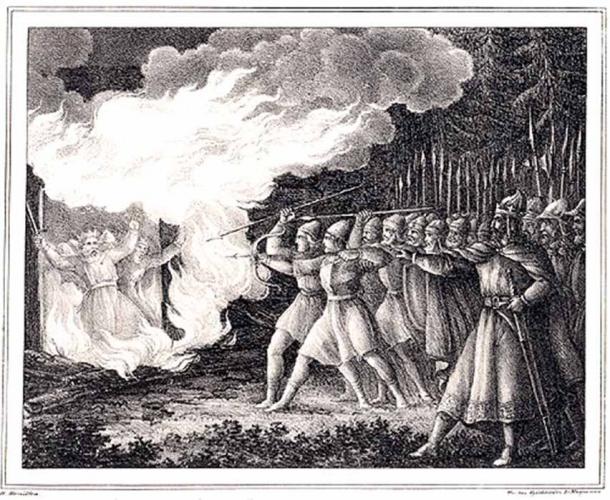
Revolt Of The Angle, Saxon and Jute Mercenaries In Britannia
Three Saxon keels slipped effortlessly through the waves towards the Kentish coast. The white cliffs glided past as the rowers, 20 on each side kept a constant rhythm. The shallow-draft oaken hull, 90 feet long (27 meters), drew just four feet of water. The shores of Britannia were within easy reach of such ships from north-western Europe. Settlers or raiders generally put to sea March to October to make best use of prevailing winds and tides. The people of Britannia had experienced both for decades. The coast towards which the three ships turned their prows had formerly been known as the ‘Saxon Shore Command’ implying the presence of mercenaries, settlers or raiders. Perhaps a combination of all three. But the men in the three keels had not come to settle, nor did they have goods to sell.

The nine British Saxon Shore forts in the Notitia Dignitatum. Bodleian Library, Oxford. (Public Domain)
These were ‘sea-wolves’, ‘wave-riders’, warships, swift and shallow. Each ship could hold up to 50 men. The earliest record of Saxon piracy along the Channel and North Sea coasts occurred in the 280s. By the mid-fourth century contemporary writers were recording serious and continuous raiding. In the fifth century Sidonius Apollinaris, writing in Gaul, described in harrowing terms their predatory nature, how they sacrificed one in ten captured slaves to the waves. But these men were not raiders. Not this time.
The Finn’s Fort Blood Feud
Such men only braved the late-winter sea for good reason. Reason they had. Behind them lay a blood-feud and the burning shell of a King’s hall in Friesland. The Finnsburg Fragment records Hnæf, ‘half-Dane’ and Scylding, had visited his sister and her husband, Finn, King of the Frisians. Treacherously attacked, Hnæf and his 60 “war-bears” held the doors to their guest-hall for five days and nights without loss. Frisian corpses piled up around the doors in their attempts to break through. By the end of the fighting Hnæf lay dead as did his nephew, Finn’s son. A Jute named Hengest took leadership of the remaining men within the great hall. A truce was agreed, oaths exchanged and many of Hnæf’s men were allowed to leave before the winter ice.

Burning enemies alive in a Great Hall, by Hugo Hamilton (Public Domain)
Hengest remained behind, brooding. The new year thaw brought the return of some of his men and Hengest’s mind turned to vengeance.
Like this Preview and want to read on? You can! JOIN US THERE ( with easy, instant access ) and see what you’re missing!! All Premium articles are available in full, with immediate access.
For the price of a cup of coffee, you get this and all the other great benefits at Ancient Origins Premium. And - each time you support AO Premium, you support independent thought and writing.
Tony Sullivan is the author of King Arthur: Man or Myth?; The Battles of King Arthur; and The Roman King Arthur? Lucius Artorius Castus, which dismantles the Artorius-Arthur theory and places this historical Roman officer in the reigns of Severus and Caracalla. His latest book is: The Early Anglo-Saxon Kings
Top Image: Hengist by John Speed's "Saxon Heptarchy" (1611) (Public Domain)
By: Tony Sullivan














